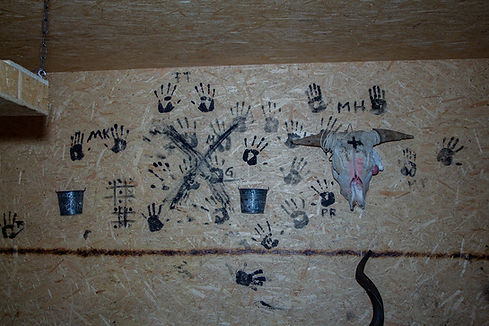
Perchtn. Tradition and custom.
"Perchtn. Traditions and Customs" is a book object that captures the fascinating world of Perchten from the Alps. This project was born out of my own enthusiasm and curiosity for the Perchten season, which I discovered during my school days in Munich. When many of my classmates had no idea what I was talking about, the idea was born to create an illustrated book that would bring this impressive tradition closer.
The inspiration for this project came in part from Nan Goldin, whose work inspired me to capture certain scenes of life photographically. Throughout the Perchten season in December, I accompanied the members of the Wildbarren Pass for four days. I was painted black, just like them, and immersed myself completely in this living tradition. The aim was to bring the Perchten closer to the people of Munich - only an hour away from the Alps, but often so far away from this tradition.
Artistic Direction , Copywriting, Photography- Ninsko
Design - Ninsko
The book consists of several chapters that shed light on different aspects of the Perchten tradition:
Personal stories: Tales from people who have grown up with the tradition and those who have rediscovered it. They tell how their initial fear turned into euphoria when they got to know the people behind the masks.
Mask carver interview: A conversation with a long-time mask carver about his work and the importance of handmade wooden masks, complemented by a series of pictures of his artwork.
A look behind the mask: portraits of WildbarrenPass members with and without masks, as well as helpers. The pictures and handwritten comments on their commitment to the custom were taken on a building site with a simple folding background, but look as if they were shot in a professional studio.
Where the Perchten live: A photo series about the Wildbarren Pass barn where they rehearse, meet and often stay overnight during the season.Materials and production




Four different types of high-quality paper were used for the book:
Cover and spine: 300g white paper.
Chapter about the mask carver and the Stadl: Recycled paper with a coarse grain to emphasize the handwork.
Chapter about the people of the Wildbarren Pass and the look behind the mask: 150g clear white paper to emphasize the strongest chapter also materially. Handwritten comments from the members are on transparent paper to further emphasize their personal insights.
Introduction and personal stories: Plain white paper.
The book is bound in Japanese thread binding, with an open spine that offers a special insight into this unique scene and reflects the raw compactness of the Perchten.


Chapter1:
Perchtn?!
Offset 100g, 20x25
Chapter2:
Kronthaler
RecycleCirlce Offset
110g, 19x25


Chapter3:
Behind the mask
Offset 150g, 20x25
Chapter 4:
Höllentrip
Offset 100g, 20x25


Chaper 5:
Perchtn?!
RecycleCircle Offset 110g, 20x25
Poster series for the event-tour 23
The project "Perchtn. Traditions and Customs" has a deep personal and artistic meaning for me. It was an intense journey that not only allowed me to immerse myself in the fascinating world of Perchten, but also to significantly expand my skills as a photographer and designer.
Through this project I was able to hone my photographic skills by taking on the challenge of capturing dynamic and often fast-changing scenes in striking images. The four days I spent closely with the members of the Wildbarren Pass were an exciting experience that helped me to develop an even deeper understanding and appreciation for this living tradition. This closeness and trust of the Perchten allowed me to capture authentic and intimate moments.

Creating this book object was a true school of time management and project planning. From the initial idea to the finished product, I had to plan and coordinate precisely to ensure that all elements - photography, texts, interviews and book design and printing - came together harmoniously. This experience strengthened my organizational skills and stamina.
Another important aspect was learning the art of bookbinding. Choosing to bind the book myself allowed me to maintain control over every aspect of the project and materials, and to develop a deeper connection to my work. The Japanese thread binding I chose symbolizes for me the openness and authenticity I want to convey with this book.
Overall, this project has broadened my creative horizons and taught me valuable lessons in craftsmanship, project management and creative self-realization. It is not only a graduation project, but also a milestone in my artistic career that has shown me the importance of investing passion and tenacity into any creative endeavor.








































































































